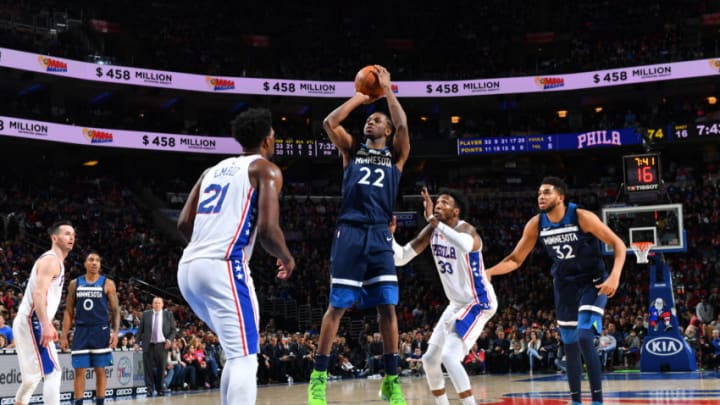The final Minnesota Timberwolves player review examines Andrew Wiggins’ fourth NBA season, which was nothing short of a roller coaster.
We’ve told the story of Andrew Wiggins quite a bit: unfairly-hyped first-overall draft pick of Cleveland in 2014, traded to Minnesota in the Kevin Love three-team trade that same summer, Rookie of the Year award-winner in 2014-15, and gradual improvement over his first three seasons in the NBA.
Wiggins has been a polarizing figure among Timberwolves fans; yours’ truly has admittedly been especially tough on him. And it’s not because of the sky-high expectations that have followed the now-23-year-old around since before high school, but because of the persistent overrating of Wiggins’ one unquestionable “skill”: volume scoring.
Wiggins was a 20-plus point per game scorer as a 20-year-old sophomore in the NBA. One simply cannot accomplish such a feat without being supremely talented and having ample opportunity — both of which Andrew had in 2015-16.
But efficiency matters, of course, and Wiggins took 16 shots to score 20.7 points per game in Year Two. He only shot 30.4 percent from 3-point range across his first two seasons, too. Wiggins was, however, fantastic at getting to the charity stripe, managing a .424 free throw rate between 2014-15 and 2015-16.
That all changed over the next two seasons, however, coinciding with Tom Thibodeau’s hiring as head coach. While Wiggins shot the ball better over the past two seasons, and he scored a career-high 23.6 points per game in 2016-17 with Thibodeau as his coach. But his free throw rate slipped and his numbers plummeted across the board after the addition of Jimmy Butler prior to the just-completed season.
The 2017-18 campaign saw Wiggins shoot just 43.8 percent from the field and a putrid 64.3 percent from the free throw line. After notching a career-high 35.6 percent on 3-point attempts last year, Wiggins’ final percentage dipped to 33.1. That meant that his true shooting percentage was a career-worst 50.5.
Wiggins did appear to make strides on defense, and most of the advanced metrics you’ll find will support that observation. His steal and block rates inched upwards, too.
It’s difficult to know just how much of Wiggins’ disappointing season was due to adjusting to his new role as the third scoring option (it was reported that Wiggins expressed some midseason displeasure with the role) versus a legitimate stagnation in development. Given his improvements in 2016-17, it seems more likely that the former is the case.
I wrote about Wiggins’ adjustment to his new role shortly after Butler’s knee injury. Here’s an excerpt from my conclusion:
"So, what does all this mean? In short, Wiggins has been the player forced to make the most adjustments in the Wolves’ new, Jimmy Butler-centric offense. Sure, Wiggins still has a higher usage rate than Towns and is still attempting more than two more shots per game than KAT, but the types of shots that Wiggins is taking has strayed much farther from his past, Butler-less life than Towns’.Just a year ago, Wiggins was getting a full possession more per-game in post-up situations than he is today. Now, he’s spending far too much time floating on the perimeter as a non-threatening 3-point shooter. Wiggins is most effective in the deep post and as a cutter (Wiggins scores a whopping 1.56 PPP as a cutter — the same number as Anthony Davis), but instead is being miscast in a Jimmy Butler-esque role as a pick-and-roll ball-handler and spot-up shooter."
Barring any unforeseen roster changes over the summer, Wiggins will have a second crack at being the Wolves’ third wheel. He’s surely learned a thing or two from Butler, and familiarity playing alongside Jeff Teague will help, too.
Of course, you’d be forgiven to have concerns with a 23-year-old who has only shown marginal improvement in a variety of areas over the past four seasons.
Next: Top 5 Individual Games By Wolves Players in 2017-18
No matter how you slice it, it was a frustrating year for Wiggins. But that also doesn’t mean that he won’t have a breakthrough at some point. He’s just too talented to be a volume-scoring, average-defending wing for the rest of his career. Here’s hoping that the breakthrough happens soon.
